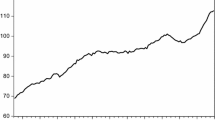Abstract
The purpose of this paper is to analyze the financial turmoil of the US subprime loan crisis of mid-Noughties and to compare it with the Japanese asset bubble of late 1980s. While examining the two crises, it compares the monetary policies of both countries, focusing on the excess liquidity and expansion of bank loans that were seen. This paper develops several bubble indicators, including the ratio of real estate loans to total loans, the loan-to-GDP ratio, and housing affordability. In order to develop these indicators, it is necessary to compare banking behavior in both Japan and the United States, as banks in both countries were making loans beyond the point of profit maximization. Property prices and monetary policy in both countries influenced banking behavior significantly. The bubble indicators developed in this paper can be used as early warning indicators for future bubbles.










Similar content being viewed by others
References
McNelis PD, Yoshino N (2012) Macroeconomic volatility under high accumulation of government debt: lessons from Japan. Adv Complex Syst 15(Suppl. No. 2):1250057-1–1250057-29
Revankar N, Yoshino N (2008) An empirical analysis of Japanese banking behavior in a period of financial instability. Keio Econ Stud 45(1):1–15
Yoshino N (2010) Policy financial crisis and policy issues in Japan, Chapter 8 In: Swee-Hock S, Wong J (eds) Managing economic crisis in East Asia. East Asian Institute, Singapore
Yoshino N (2012a) Proper monetary policy faced with worldwide economic recession. APEC SME Crisis Monitor, APEC SME Crisis Management Center, No. 18, January 2012
Yoshino N (2012b) The global imbalance and the development of capital flows among Asian countries. OECD J Financ Mark Trends 1:2012
Yoshino N, Hirano T (2011) Pro-cyclicality of the Basel capital requirement ratio and its impact on Banks. Asian Econ Papers, MIT Press 10(2):22–36
Yoshino N, Hirano T (2013) Counter cyclical buffer of the Basel capital requirement and its empirical analysis. Current developments in monetary and financial law, IMF Vol. 6. Chapter 16
Yoshino N, Hirano T, Miura K (2009) The optimal Basel capital requirement to cope with pro-cyclicality: a theoretical approach. (Financial Research Institute, Financial Services Agency (FSA), Government of Japan FRTS Discussion papers, DP2009-6, http://www.fsa.go.jp/frtc/english/seika/discussion.html
Yoshino N, Kaji S, Asonuma T (2012) Choices of optimal monetary policy instruments under the floating and the basket-peg regimes. Singapore Econ Rev 57(4):12500245
Author information
Authors and Affiliations
Corresponding author
Rights and permissions
About this article
Cite this article
Yoshino, N., Nakamura, T. & Sakai, Y. International comparison of bubbles and bubble indicators. AI & Soc 29, 427–434 (2014). https://doi.org/10.1007/s00146-013-0469-8
Received:
Accepted:
Published:
Issue Date:
DOI: https://doi.org/10.1007/s00146-013-0469-8




